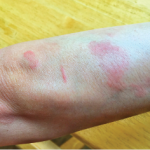Patients with COVID-19 who were also positive for LAC had higher levels of fibrinogen (median 6.0 gm/L [interquartile range 5.0–7.0]) compared with LAC negative (5.3 gm/L [interquartile range 4.3–6.4]; P=0.028) and C-reactive protein (CRP) (median 115.5 mg/L [interquartile range 66.0–204.8] vs. 91.8 mg/L [interquartile range 27.0–155.1]; P=0.019). Univariate analysis did not show any association between LAC positivity and higher risks of venous thromboembolism (odds ratio 1.02 [95% confidence interval 0.44–2.43], P=0.95) or in- hospital mortality (odds ratio 1.80 [95% confidence interval 0.70–5.05], P=0.24).
Adjusted Kaplan-Meier survival curves, for patients with and without LAC positivity, confirmed the absence of an association with venous thromboembolism (HR 1.13, 95% confidence interval 0.48–2.60) or in-hospital mortality (HR 1.80, 95% confidence interval 0.67–5.01).
Conclusion
Patients with COVID-19 have an increased prevalence of LAC positivity associated with biologic markers of inflammation. However, LAC positivity at the time of hospital admission is not associated with the risk for venous thromboembolism and/or in-hospital mortality.
Refer to the full study for all source material.
Excerpted and adapted from: Gendron N, Dragon-Durey MA, Chocron R, et al. Lupus anticoagulant single positivity during the acute phase of COVID- 9 is not associated with venous thromboembolism or in-hospital mortality. Arthritis Rheumatol. 2021 Nov;73(11).

